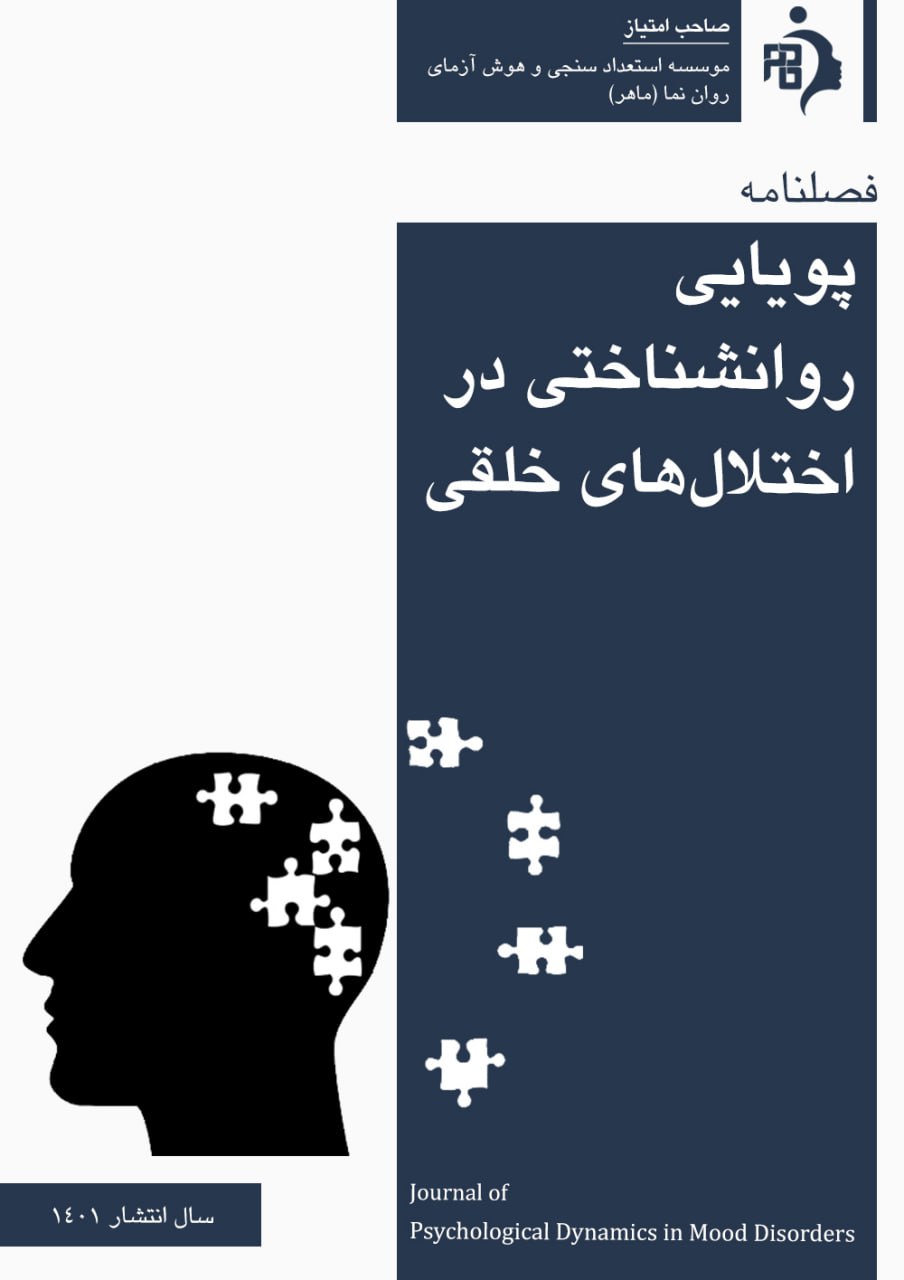بررسی ویژگیهای روانسنجی مقیاس تداخل زندگی اضطرابی کودک (فرم کودک)
کلمات کلیدی:
ویژگیهای روانسنجی, تداخل زندگی, اضطراب کودک, تداخل زندگی اضطرابی کودکچکیده
زمینه و هدف: اضطراب سازهای مهم در دوران کودکی است که پیامدهای روانشناختی منفی زیادی دارد. بنابراین، هدف این پژوهش بررسی ویژگیهای روانسنجی مقیاس تداخل زندگی اضطرابی کودک بود.
روش و مواد: این پژوهش از نظر هدف، کاربردی و از نظر شیوه اجرا، توصیفی بود. جامعه پژوهش کودکان 15-10 سال استان مازندران بودند که تعداد 370 نفر از آنها با روش نمونهگیری تصادفی خوشهای چندمرحلهای انتخاب شدند. ابزارهای پژوهش شامل مقیاس تداخل زندگی اضطرابی کودک (لینهام و همکاران، 2013) و مقیاس اضطراب کودکان (اسپنس، 1997) و مقیاس تجدیدنظرشده اضطراب آشکار کودکان (رینولدز و ریچموند، 1978) بودند. دادههای این مطالعه با روش تحلیل عاملی اکتشافی در نرمافزار SPSS تحلیل شدند.
یافتهها: یافتهها نشان داد که مقیاس تداخل زندگی اضطرابی کودک دارای دو عامل تداخل در عملکرد خارج از خانه و تداخل در عملکرد داخل خانه بود. بار عاملی گویههای هر دو عامل بالاتر از 50/0 بود و پایایی عاملهای مذکور در دختران و پسران و کل نمونه با روش آلفای کرونباخ در دامنه 70/0 تا 78/0 بهدست آمد. علاوه بر آن، روایی همگرای مقیاس تداخل زندگی اضطرابی کودک، عاملهای تداخل در عملکرد خارج از خانه و تداخل در عملکرد داخل خانه با مقیاس اضطراب کودکان و مولفههای آن و مقیاس تجدیدنظرشده اضطراب آشکار کودکان معنیدار بود (001/0P<). همچنین، پایایی برای مقیاس تداخل زندگی اضطرابی کودک، تداخل در عملکرد خارج از خانه و تداخل در عملکرد داخل خانه با روش بازآزمایی دو هفتهای بهترتیب 85/0، 81/0 و 77/0 محاسبه شد.
نتیجهگیری: با توجه به شاخصهای روانسنجی مناسب برای مقیاس تداخل زندگی اضطرابی کودک، متخصصان و درمانگران حوزه سلامت میتوانند از این ابزار برای اندازهگیری تداخل زندگی در اضطراب کودکان استفاده نمایند.
دانلودها
مراجع
Amitai, M., Kaffman, S., Kroizer, E., Lebow, M., Magen, I., Benaroya-Milshtein, N., & et al. (2022). Neutrophil to-lymphocyte and platelet-to-lymphocyte ratios as biomarkers for suicidal behavior in children and adolescents with depression or anxiety treated with selective serotonin reuptake inhibitors. Brain, Behavior, and Immunity, 104, 31-38. https://doi.org/10.1016/j.bbi.2022.04.018
Bakhtiari, Z., Asadi, J., & Bayani, A. A. (2020). Comparison the effectiveness of “drama therapy” and resilience training on anxiety and aggression of children with depression. Journal of Health Promotion Management, 9(5), 34-47. http://jhpm.ir/article-1-1194-en.html
Breinholst, S., Walczak, M., Christiansen, B., & Esbjorn, B. (2021). A therapist-guided parent-delivered self-help group for anxiety disorders in children: An effectiveness study. Journal of Behavioral and Cognitive Therapy, 31(12), 105-113. https://doi.org/10.1016/j.jbct.2020.11.008
Chen, X. C., Xu, J. J., Yin, X. T., Qiu, Y. F., Yang, R., Wang, Z. Y., & et al. (2024). Mediating role of anxiety and impulsivity in the association between child maltreatment and lifetime non-suicidal self-injury with and without suicidal self-injury. Journal of Affective Disorders, 347, 57-65. https://doi.org/10.1016/j.jad.2023.11.080
Dahlsgaard, K. K., Lewis, M. O., & Spergel, J. M. (2023). Cognitive-behavioral intervention for anxiety associated with food allergy in a clinical sample of children: Feasibility, acceptability, and proof-of-concept in children. Annals of Allergy, Asthma & Immunology, 130(1), 100-105. https://doi.org/10.1016/j.anai.2022.09.021
Espeedkar, M., Manavipour, D., & Pirkhaefi, A. (2024). The role of grandparents in the repairing or damaging of attachment security of children of avoidant insecurely attached: A qualitative study. Psychological Dynamics in Mood Disorders, 2(4), 1-9. https://doi.org/10.22034/pdmd.2024.444520.1049
Hickman, C., Marks, E., Pihkala, P., Clayton, S., Lewandowski, R. E., Mayall, E. E., & et al. (2021). Climate anxiety in children and young people and their beliefs about government responses to climate change: a global survey. The Lancet Planetary Health, 5(12), 863-873. https://doi.org/10.1016/S2542-5196(21)00278-3
Johnson, A. A., Berry, A., Bradley, M., Daniell, J. A., Lugo, C., Schaum-Comegys, K., & et al. (2021). Examining the effects of music-based interventions on pain and anxiety in hospitalized children: An integrative review. Journal of Pediatric Nursing, 60, 71-76. https://doi.org/10.1016/j.pedn.2021.02.007
Karaca, T. N., & Guner, U. C. (2022). The effect of music-moving toys to reduce fear and anxiety in preschool children undergoing intravenous insertion in a pediatric emergency department: A randomized clinical trial. Journal of Emergency Nursing, 48(1), 32-44. https://doi.org/10.1016/j.jen.2021.10.004
Ku, S. H., Chua, J. S., & Shorey, S. (2025). Effect of storytelling on anxiety and fear in children during hospitalization: A systematic review and meta-analysis. Journal of Pediatric Nursing, 80, 41-48. https://doi.org/10.1016/j.pedn.2024.11.006
Lyneham, H. J., Sburlati, E. S., Abbott, M. J., Rapee, R. M., Hudson, J. L., Tolin, D. F., & Carlson, S. E. (2013). Psychometric properties of the child anxiety life interference scale (CALIS). Journal of Anxiety Disorders, 27(7), 711-719. https://doi.org/10.1016/j.janxdis.2013.09.008
Marques, T., Pereira, A. I. F., Pedro, M. F., Rusoo, V., Goes, A. R., & Barros, L. (2015). Preliminary analysis of the Portuguese version of the child anxiety life interference scale. Psicologia Reflexao e Critica, 28(3), 454-462. http://dx.doi.org/10.1590/1678-7153.201528304
Mirjalili, R. S., Rasoulzadeh Tabatabaei, S. K., & Janbozorgi, M. (2018). Confirmatory factor structure and psychometric properties of adult version of screen for child anxiety related emotional disorders (SCARED-A). Journal of Clinical Psychology & Personality, 16(1), 223-237. https://doi.org/10.22070/cpap.2020.2850
Orgiles, M., Fernandez-Martinez, I., Morales, A., Melero, S., & Espada, J. P. (2019). Spanish validation of the child anxiety life interference scale (CALISC): Psychometric properties, factorial structure and factorial invariance across gender. Child Psychiatry and Human Development, 50(5), 756-763. https://doi.org/10.1007/s10578-019-00879-4
Reynolds, C. R., & Richmond, B. O. (1978). What I think and feel: A revised measure of children’s manifest anxiety. Journal of Abnormal Child Psychology, 6(2), 271–280. https://doi.org/10.1007/bf00919131
Roshan Chesli, R., Jalali, M., & Pourahmadi Asefestani, E. (2018). Psychometric properties of the screen for child anxiety related emotional disorders in 10-17 years old Iranian students. Quarterly of Educational Measurement, 8(31), 65-97. https://doi.org/10.22054/jem.2018.29270.1693
Salvaris, C. A., Wade, C., Galea, S., Yap, M. B. H., & Lawrence, K. A. (2023). Children’s perspectives of an enhanced cognitive-behavioral treatment for child–parent dyads with anxiety disorders. Cognitive and Behavioral Practice, 30(3), 495-510. https://doi.org/10.1016/j.cbpra.2022.02.023
Spence, S. H. (1997). Structure of anxiety symptoms among children: A confirmatory factor-analytic study. Journal of Abnormal Psychology, 106(2), 280-297. https://doi.org/10.1037//0021-843x.106.2.280
Taghavi, S. M., & Alishahi, M. J. (2003). Examining the validity and reliability of the children's manifest anxiety scale. Journal of Psychology, 7(4), 342-357. https://www.sid.ir/paper/419822/fa
Takhti, M., Shafi' Abadi, A., Kalantar Hormozi, A., & Farrokhi, N. A. (2020). The effectiveness of the parent-child interaction intervention program based on emotion coaching on the symptoms of children's separation anxiety disorder. Journal of Psychological Science. 19(95), 1423-1437. http://dorl.net/dor/20.1001.1.17357462.1399.19.95.5.1
Uzsen, H., Buyuk, E. T., Odabasoglu, E., & Koyun, M. (2024). The effects of vibration and pressure interventions on children's pain, fear and anxiety: A randomized controlled trial. Journal of Pediatric Nursing, 75, 196-204. https://doi.org/10.1016/j.pedn.2023.12.022
Vafaey Moghaddam, M., Haji Alizadeh, K., Zarei, E., & Amirfakhraei, A. (2024). Investigating the structural relationships of rumination with the mediation of body image on the anxiety of people with bulimia nervosa disorder. Psychological Dynamics in Mood Disorders, 2(4), 10-20. https://doi.org/10.22034/pdmd.2024.444564.1050
Zeinali, S., Poursharifi, H., Babapour, J., Mahmood Aliloo, M., & Khanjani, Z. (2020). The relationship between cognitive bias, anxiety sensitivity and maternal beliefs and anxiety in children: the mediating role of coping strategies. Quarterly Journal of Child Mental Health, 7(3), 53-66. http://dx.doi.org/10.52547/jcmh.7.3.6



























